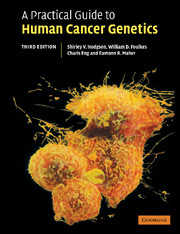Book contents
- Frontmatter
- Contents
- Dedication
- Preface
- Acknowledgements
- Part one Cancer genetic counselling
- Part two Genetics of human cancers by site of origin
- 2 Central nervous system
- 3 Eye
- 4 Cardiorespiratory system and thorax
- 5 Endocrine system
- 6 Gastrointestinal system
- 7 Reproductive system
- 8 Urinary system
- 9 Blood and lymph
- 10 Musculoskeletal system
- 11 Skin
- Part three Cancer-predisposing syndromes
- Appendix
- References
- Index
3 - Eye
Published online by Cambridge University Press: 20 August 2009
- Frontmatter
- Contents
- Dedication
- Preface
- Acknowledgements
- Part one Cancer genetic counselling
- Part two Genetics of human cancers by site of origin
- 2 Central nervous system
- 3 Eye
- 4 Cardiorespiratory system and thorax
- 5 Endocrine system
- 6 Gastrointestinal system
- 7 Reproductive system
- 8 Urinary system
- 9 Blood and lymph
- 10 Musculoskeletal system
- 11 Skin
- Part three Cancer-predisposing syndromes
- Appendix
- References
- Index
Summary
The ocular tumours discussed in this section include retinoblastoma, haemangioblastoma, optic nerve glioma, meningioma and melanoma. Ocular rhabdomyosarcoma is discussed with rhabdomyosarcoma of other sites on pages 136 and 137. Genetic disorders associated with significant ocular manifestations (neoplastic and non-neoplastic) include neurofibromatosis type 1 (NF1), neurofibromatosis type 2 (NF2), von Hippel–Lindau (VHL) disease, tuberose sclerosis and familial adenomatous polyposis (see Part Three).
Retinoblastoma
Retinoblastoma is the commonest malignant ocular tumour of childhood and affects 1 per 20 000 children. The tumour is derived from primitive retinal cells (retinoblasts) and usually presents in early childhood (90 per cent before the age of 5 years). Less than 10 per cent of children with retinoblastoma have a positive family history (where inheritance is autosomal dominant), but new mutations are frequent and approximately 40 per cent of retinoblastoma patients have a genetic predisposition. Retinoblastoma holds a unique place in human cancer genetics as the paradigm of the tumour suppressor gene.
Retinoblastoma typically presents as leukocoria (white eye, cat's eye reflex) or strabismus. It is bilateral in about 30 per cent of cases, and these children have a younger age at diagnosis (mean 8 months) than those with unilateral tumour (mean 25 months). Bilateral or multifocal tumours occur in patients with germline mutations of the retinoblastoma (RB1) gene, but about 15 per cent of children with a single tumour will have a germline mutation.
- Type
- Chapter
- Information
- A Practical Guide to Human Cancer Genetics , pp. 20 - 27Publisher: Cambridge University PressPrint publication year: 2006

